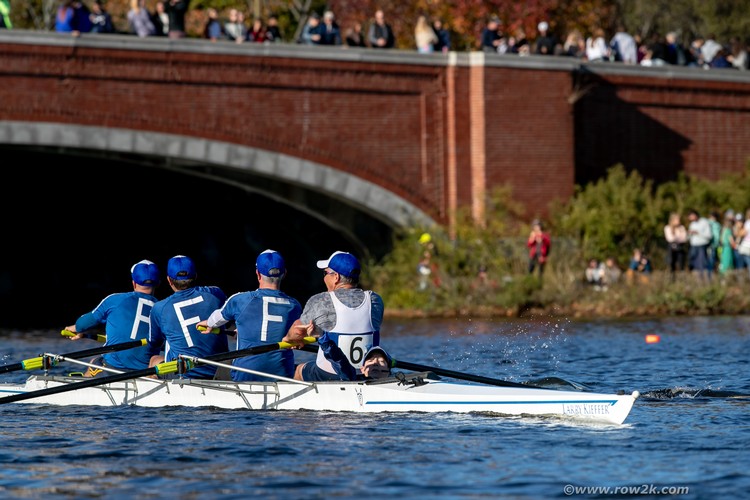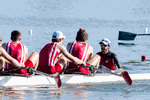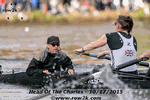In the Driver's Seat, with Taya DiAngelo
John FX Flynn

Next up In The Driver's Seat--where we hear from the folks who keep the shells straight--is coxswain, and Villanova Assistant Coach, Taya DiAngelo.
Taya first jumped into the coxswain chair her junior year of high school, in the spring of 1994, coxed four years at the University of San Diego and now races with Masters crews--usually with her home club, Philadelphia's Fairmount Rowing Association.
Let's hop In The Driver's Seat with Taya:
row2k - What are the three most important things to being a successful coxswain?
Taya DiAngelo - Obviously the most important thing to know on race day in masters rowing is who is bringing the beer, right?? But aside from that, my three essentials would be:
1. Knowing the race day logistics. As a masters' cox'n you are often without a coach for the day & having everything organized in such a way that is easy to share with your rowers is helpful. The big ones for me are:
- Race day timeline: Time to meet as a boat, hands on time, launch/shove time, race time & event number--all in a place where I can easily see it throughout the day. I write the timeline in an iPhone note & then make it the lock screen on my phone. I obsessively check the time leading up to hands on and with my full day's itinerary on my phone, that's one less thing for me to carry around with me, plus every time I check my phone to see what time it is (even though I checked the time approximately 13 seconds prior), I also get a quick reminder of when I need to be where. Bonus: when it is a note on my phone I can easily text it to my rowers so we all have all of the same info.
- Traffic pattern: especially at a new-to-me venue, but even in a place I have been in the past, I will always look up traffic pattern info to make sure it hasn't changed. The amount of information that is available online for many regattas makes this an easy thing to check prior to race day. If I have questions, I can bring them to the officials on the day of and be proactive about things.
- Race/venue specific rules: another thing I make sure to check. Most regattas are fairly standard in their time to be in the starting area, time to be locked on, etc, but you never know. Again, this comes down to the fact that often there isn't a coach at a masters' race, so it is my responsibility to check.

2. Equipment info. A bit unique to master's coxing because you often jump into lineups you haven't ever coxed before, in equipment you haven't ever steered before, whereas juniors & collegiate cox'ns can be fairly certain the boat they practice in is the boat they will race.
- The hull itself: What tools will I need to bring with me: 7/16ths or 10mm? Have I steered this hull before? If it's new to me, have I steered a boat of the same size by the same manufacturer before? If I haven't (which at my age doesn't actually happen anymore, lol, but for younger cox'ns is definitely a consideration), do I know someone who rows that type of hull & can tell me about HOW it steers? Maybe the stroke seat has tips/tricks? The more I can find out about the equipment, the better. If I can't get insider info, I use the warmup to figure out exactly how the hull steers and what it feels like at different speeds.
- Cox box: I am fortunate enough to have my own cox box so I don't need to worry about that piece of the puzzle, but many masters cox'ns aren't and they should be asking the crew if a cox box will be provided. If the team you are racing with doesn't have one, reach out to your club about borrowing one or, at the larger races, you can even ask cox box manufacturers if you can demo one for the day/weekend.
- Bow numbers: Again this is something I have in my arsenal, but prior to buying my own it was something I would ask my crew about ahead of time. While most trailers in the lot are happy to share a bow number when asked, it is easier to plan that they won't be available ahead of time and bring your own.
3. Weather forecast. I feel like this is one that gets overlooked by a LOT of cox'ns & it is a game changer when it becomes part of your routine:
- These days we have a multitude of free weather apps at our disposal, gone are the days of weather.com being the only source of info so USE THE RESOURCES! Everyone eventually finds their favorite app but something is better than nothing.
- Look up the overall day-of forecast & then go a bit further to look at the hour by hour. Many apps will give you the predicted wind speed/direction in the hourly forecast & with that, plus Google maps, you can get a decent idea of whether you will be racing in a tail or a head or everyone's favorite: the dreaded cross tail!
- The weather forecast isn't always correct, but knowing the prediction gives you an idea & that is better than winging it. Not only will it allow you to choose your layers with confidence, but it will also allow you to forewarn your rowers if the predictions are abnormal for the time of year so they can better prepare themselves. Don't let the age of your master's rowers fool you--they still appreciate a head's up from their cox'n about what layers to pack!
row2k - What is your favorite drill to run with your crews? Any tips on how to do the drill well, for maximum effectiveness?
Taya DiAngelo - If I absolutely have to pick ONE DRILL, I have to go with the Pick Drill. It has stood the test of time for a reason & I'm one who likes to keep things simple. What could be simpler than working from the finish up to full slide?
If time allowed I would start every masters' practice with some kind of pick drill to get everyone on the same page from the very beginning. Anyone in masters rowing knows that a set lineup isn't likely to occur from day to day and starting with arms only working up to full slide allows everyone to understand the rhythm of the stroke early on in practice.

Another reason I love pick drill is its versatility: it can be a super quick affair with a simple 5 strokes at each stroke length, or you can extend it & add pauses into continuous strokes, or you can start off with outside or inside arm only and move into regular grip at each stroke length, or you can go from partial boat to full boat--the possibilities are nearly endless and every single rower of every single experience level can learn something from it.
To get the maximum effect from your "run of the mill" pick drill, the cox'n has to be clear with their transition calls & really know the "why" behind each stage of the drill so they can give that to their rowers as they progress to full slide. Clarity in transition calls allows the rowers to remain present in the current stroke & keeps their thoughts about what's up next or when will we switch to a minimum. Knowing the "why" simply allows the cox'n to keep their tips relevant to the stroke length; instead of just filling the space with words, a cox'n who knows how each stage of the drill enhances the full stroke can really get the most out of a seemingly basic exercise.
row2k - What's some of the best coaching advice you've received about your coxing?
Taya DiAngelo - I can't say for certain whether this was actual coaching advice given to me, or just something I have learned over the years, but to this day the thing that helps me the most is listening to my own audio. I don't know many people (perhaps I don't know ANYONE?) who likes listening to their own audio. For myself, I find the cringe factor nearly unbearable, but it is hands down the best way I have found to improve. I suffer through my own voice echoing in my head in order to continually get better. I typically will listen once without pausing it, just really reminding myself what the piece was & how it evolved. Sometimes I do that a second time, but if I am listening to the audio within a day or two of recording I can get away with one time through & then I get down to business dissecting it.
Evaluating my own audio the way I might evaluate a prospective collegiate recruit's recording gives me the ability to step back & evaluate if the things I am saying are useful or just filling the gaps. It is not exciting in the least, & the notes I take aren't legible to most other people as I am scribbling stuff in between listening, pausing, rewinding, re-listening, etc., but it is amazing what I can learn from taking the time to do it properly. I think the key is making sure to listen to all sorts of situations & not just racing; listening to a long steady state piece after the fact can really be eye opening (even more so if you have the speed coach/cox box data alongside of it so you can see if things you said had an immediate impact on the speed). With all the different free recording apps available these days, there's just no excuse. I would challenge every cox'n out there to record themselves at least once every few outings, take time to REALLY LISTEN to the recording & see what they learn from it.
row2k - What is a mid-race call or move that you've made that you'll remember for the rest of your life? What did it involve and how did you call it?
Taya DiAngelo - I'm going to go with Head of the Charles in 2016: I had the honor of racing with an international group of kick-ass master's women & we were going off in the middle of the pack so we were pretty sure there would be some passing involved in the race. We passed a few early and, if memory serves me right, we had our own water coming out of Powerhouse & through Weeks (yay!). Even as we came under Anderson the path was clear, but we were gaining on the next cluster of boats so there was a good chance the "big turn" was going to get spicy.

Sure enough, things unfolded in a way where we were passing multiple crews as we approached the apex of the buoy line and I was faced with either splitting two slower crews and taking a slightly wider line in the beginning of the turn, or ducking both crews and claiming the buoy line as ours. It's an easy decision, in theory--OF COURSE you duck in and take the inside!--but when moving at speed with crews who may not move out of your way and who are moving significantly slower than you, it becomes less black and white.
Being slightly cocky about my head racing skills, I chose to duck both crews and take the line. I called my crew down ever so slightly in pressure (and what cox'n doesn't love a crew who can respond to that call in the middle of a race?!?!) and moved my bow ball from the starboard side of their stern over to port, put our oars over the buoys and got right back up to speed. Thankfully, both of the cox'ns in the crews we were passing were quick to yield and everyone continued sans even an oar clashing. I have no memory of how I called it or how we navigated it so cleanly, but I had a GoPro mounted on the bow deck that year and when I watched the footage I was shocked at how close our bow ball came to their stern tip, I want to say it was skill but there was a good deal of luck that came into play there, too. So while I called the move, the credit really goes to the rowers who executed what I was asking, and the other coxswains around me who were on their game enough to yield and keep everyone in the race fairly.
Honestly, to have a crew that is quick to respond & trusts their coxswain enough to do exactly what they are asked to do when they are asked to do it? That is the dream. The freedom it gives you as a coxswain when you know your rowers trust you is an awesome feeling and probably one of the main reasons I still squeeze myself into the seat on a regular basis.
row2k - Can you tell us anything about how you learned to steer straight?
Taya DiAngelo - Nope. I mean honestly, I have no idea how I learned to steer straight!
This is what I tell the cox'ns I coach: "You will think about steering all the time, and it will kind of consume your brain power out on the water, until one day you will get off the water and realize you no longer think about it and no one has commented on your steering in a while. That's when you come to find out you just might know what you are doing."
If I have to guess, I am quite sure it was all trial & error. In the very beginning you learn how to steer and you oversteer all the time. Eventually, you start figuring out how not to oversteer during practice & drills, but when you are at speed you still find yourself oversteering because the boat responds so much quicker. Then at some point, you find you can keep a boat relatively straight when you are at speed on your home body of water and you think you have figured it all out--hooray!--only to find out that when you are put between two buoy lines or on another team's course, you are right back to feeling like you have no idea what you are doing. But eventually, over time in the seat, you really do learn the nuances of steering straight.
You learn when you will need to use more rudder vs less; you learn what works best for you on how to pick and hold a point; you learn how to stay between buoys and not "bounce" from one line to the other. Some people just get it, and for others it takes more time, but if someone has the magic way to teach a cox'n to steer straight from the very beginning???? Please let me know!

row2k - Best race/practice you've ever had? And worst/race/practice?
Taya DiAngelo - This is tough...let's keep this simple & go with my best & worst races at San Diego Crew Classic as a master. There is a VERY good chance these aren't actually my "best" and "worst" races ever, but they stick in my memory so I'm going with them.
My hands down favorite San Diego Crew Classic has to be 2013, the year I somehow found myself a not-so-young cox'n in a very young alumni boat (ahem, as in they graduated less than one year prior to the race). Jumping in a boat with women who had basically just come off of training at a high intensity and were ready to reclaim SDCC as their own was SO fun. We were seeded in lane one so we knew we had the advantage, but in alumni races you really never know. In the end, we won by the skin of our teeth and it was one of those races you finish as a cox'n and know for a fact you made a difference in their result.
On the flip side? A San Diego Crew Classic where I can easily say I cost my crew the win and it broke my heart. If anyone has raced SDCC, you know the buoys are slightly further apart than a "typical" buoyed course and, because of that, if you get slightly off course, it isn't so easy to reposition yourself into your lane; there's a strange optical illusion that happens. But here's the thing: it shouldn't happen to HOME COURSE cox'ns, right?
We know the deal & know how important it is to stay in the lane and use a point in the distance rather than the lane lines. So if you look up at where I spent my collegiate years and see that SDCC was my backyard and home course, and then see that this race in particular is one of my worst memories as a master cox'n you may be able to put two and two together...
Yep, I ended up just off course, then having to correct and then coming in second by less than a second. To this day, I do not care what anyone says: that is on me. The women I was steering 100% should have won and my steering cost them that. They were gracious and much kinder to me than I was to myself in the moments after finishing; for that, I am thankful.
The real question becomes: what did I learn? It took me a bit to stop beating myself up, I won't lie, but once I shook off the self-blame I was able to learn the lesson and for me it came down to this: I wasn't fully present in that race. I got cocky and didn't spend my weekend mentally preparing the way I typically do. That cost my crew the win. I hate that my lesson came at the expense of eight badass women, but I know for a fact it has enhanced my racing in the years since and I am now able to say "no" if I am asked to cox and know I won't be able to take the time prior to prepare.
Thanks for riding along with Taya and remember, this column is open to all "drivers" out there, so if you are an experienced coxswain at any level--from juniors to masters--and would be willing to invite row2k to join you in your ride, just contact us here. We'd love to hear from you about what you see from the Driver's Seat.

If you enjoy and rely on row2k, we need your help to be able to keep doing all this. Though row2k sometimes looks like a big, outside-funded operation, it mainly runs on enthusiasm and grit. Help us keep it coming, thank you! Learn more.
Comments | Log in to comment |
- Bont Rowing
- Calm Waters Rowing
- Concept 2
- Craftsbury Sculling
- The Crew Classic
- CrewLAB
- Croker
- Dad Vail Regatta
- Durham Boat Co.
- Empacher
- Faster Masters
- Filippi
- Fluidesign
- h2row.net
- HUDSON
- Live2Row Studios
- Nielsen-Kellerman
- Oak Ridge RA
- Peinert Boat Works
- Pocock Racing Shells
- Race1 USA
- RowKraft
- Rubini Jewelers
- Vespoli USA
- WinTech Racing
- Bont Rowing
- Calm Waters Rowing
- Concept 2
- Craftsbury Sculling
- The Crew Classic
- CrewLAB
- Croker
- Dad Vail Regatta
- Durham Boat Co.
- Empacher
- Faster Masters
- Filippi
- Fluidesign
- h2row.net
- HUDSON
- Live2Row Studios
- Nielsen-Kellerman
- Oak Ridge RA
- Peinert Boat Works
- Pocock Racing Shells
- Race1 USA
- RowKraft
- Rubini Jewelers
- Vespoli USA
- WinTech Racing



















06/23/2022 11:07:01 AM